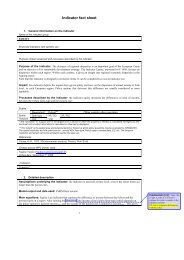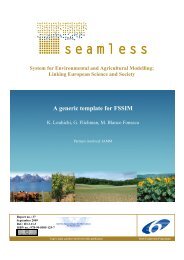Farming Systems Design 2007 - International Environmental ...
Farming Systems Design 2007 - International Environmental ...
Farming Systems Design 2007 - International Environmental ...
Create successful ePaper yourself
Turn your PDF publications into a flip-book with our unique Google optimized e-Paper software.
<strong>Farming</strong> <strong>Systems</strong> <strong>Design</strong> <strong>2007</strong><br />
Field-farm scale design and improvement<br />
whole society. According to its new “multifunctional role”, besides ensuring food and fibre<br />
production, agricolture should also contribute to the environmental safeguard, to the supply of<br />
recreational services, to the creation of alternative opportunities for income and employment<br />
for the farmers, and so on. MAPs fit very well in this, and represent a good opportunity for agrotouristic<br />
concerns, helping in attracting people from the cities by means of the development of<br />
herbs-based commercial items (handicraft, oils, extracts, honey) besides representing a further<br />
source of aesthetic land valorization.<br />
MAPs and biodiversity<br />
The widespread belief that only under “natural” conditions MAPs find their optimum quality features<br />
has driven in many cases to their uncontrolled collection from the wild, and as a result many of<br />
them are nowadays at a risk of extinction. The field cropping of such spontaneous species could<br />
play an important role in safeguarding biodiversity.<br />
MAPs and integrated development<br />
Inside the intervention lines feasible for the sustainable exploitation of marginal lands, a great<br />
attention is paid to the integration of economic development, social development and<br />
environmental protection as “interdependent and mutually reinforcing pillars of sustainable<br />
development” (UN-CSD, <strong>2007</strong>). One of the main goals is to promote all those economical activities<br />
that fit in unitary production pathways, besides the production of raw matter also including the first<br />
transformation and, whenever possible packaging and marketing processes. Most MAPs fit very<br />
well in such line, having a strong aptitude to be transformed by means of low-cost in-farm<br />
equipments, that could help farmers in increasing their income level by retaining in farm the added<br />
value due to the transformation process.<br />
MAPs and organic agriculture<br />
The growing diffusion in Mediterranean environments of the organic production technique offers to<br />
MAPs new possibilities, being such crops mostly suitable to cultivation with a reduced use of<br />
energetic and technological inputs (Demarco et al., 1999). When their “naturality” features are<br />
enhanced by means of the organic labelling, MAPs have the possibility to meet the requests of<br />
more careful and exigent consumers, disposed to pay more for a “natural” and “healthy” product.<br />
MAPs and agroforestry<br />
The new trends in agroforestry claim that the introduction of MAPs inside the agroforestry system<br />
is a useful way to increase biodiversity and gain a significant increase in income (Huang et al.,<br />
2002). In such sense, they could be grown together with trees (that should however remain the<br />
main crop) generating highly positive interactions. As a matter of fact, in many areas of the world<br />
non-wood forest products, including MAPs, are the main income generating activity from the<br />
forests and several rural communities depend on these products for their living.<br />
Conclusions<br />
Our survey shows that MAPs cultivation could be implemented in a productive way throughout<br />
many Mediterranean marginal lands and could help in solving some of the major land-use<br />
problems.<br />
References<br />
M.F Demarco et al., Good agricultural practices for the organic production of medicinal plants, 1999. Acta<br />
Horticolturae, 502, 21-27.<br />
FAO-CGIAR, Reducing Poverty through Cutting-edge Science. CGIAR Research Priorities for Marginal<br />
Lands, 1999. <strong>International</strong> Centers Week, October 25 – 29, Washington D.C.<br />
COM (Commission of the European Communities), Halting the loss of biodiversity by 2010 and beyond –<br />
Communication from the Commission, 216 final, Brussels, 22.5.2006.<br />
UN-CSD (United Nations Commission on Sustainable Development), Report on the fifteenth session<br />
Economic and Social Council - Official Records, <strong>2007</strong> - Supplement No. 9- E/<strong>2007</strong>/29 - E/CN.17/<strong>2007</strong>/15<br />
W. Huang et al., Agroforestry for biodiversity conservation of nature reserves: functional group identification<br />
and analysis, 2002. Agroforestry systems, 55, 65-72.<br />
- 20 -




